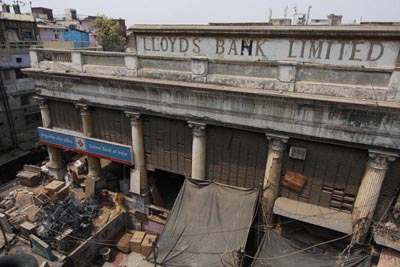Bhagirath Palace

Information on Bhagirath Palace (New Delhi) - History & Architecture
Begum's Palace which is commonly known as 'Bhagirath Palace' is a popular monument which was actually a fortress of a princess named Begum Samru. The palace is situated in Chandni Chawk of Old Delhi and is regarded as a grandeur through British realm. Among various other palaces of Begum Samru, the one which is situated in Chandni Chawk is celebrated to be the most magnificent. Begum's Palace lived its era of splendour during the British dominion and it is a wonderful historical monument of Delhi.
Bhagirath Palace Architecture
Begum's Palace was created in classical architectural style with marble baths. The palace was created on a garden named 'Samru Bagh', which was gifted to her by emperor Akbar Shah after he taken over the throne of Shah Alam in the year 1806. Samru's Palace is actually an imposing European palace exemplifying the taste of Samru herself. The walls and pillars of the palace have exclusive ancient designs. However, time and negligence have entirely damages the architectural prodigy of this building. Begum's Palace has lost its gleam throughout the rebellion in the year 1857. At present, a portion of the palace is entirely demolished, while the other portion is completely changed.
Historical data states that Begum's Palace had nine fountains in the extravagantly laid grasslands. It was an impressive four storeyed construction created by stonework and marble. Owing to the European relationship of Samru through her husband, the palace characterises fine combination of Greek, Roman, Corinithian and Mughal architectural style. Begum's Palace was renowned for its long zigzagging stairways and extensive walkways. Although there are various lavish explanations regarding how Begum's Palace used to look like in previous days, it is a fact that most of it is conjecture and assumption.
Bhagirath Palace History
Begum Samru's original name was Begum Joanna Nobilis Sombre who was initially a dancing girl until she became the ruler of Sardhana of Uttar Pradesh. She played significant part in political events during 18th and 19th century. She was eminent by her excellent leadership capabilities. In early teen age, she wedded a British acquisitive soldier of Luxembourg who was the possessor of the fief of Sardhana. She was affectionately called Sombre due to her gloomy face and hence the name Samru was derived and become popular. After the death of her husband, Samru transformed herself to Christian religion for strategic and personal motive in the year 1781. She managed her authority in tactful manner. In the year 1803, when British rule settled in Northern part of India, she recalled her position of an independent ruler of Sardhana.
In the year 1806 King Akbar Shah ascended Mughal power and he gifted Begum a beautiful impressive palace in Chandni Chawk. He did so because Begum saved his throne in Delhi from an invasion of Sikh army. The gifted palace was ornamented with high ceilings, big airy rooms and a huge garden, spreading over half area of Chandni Chawk. Begum Samru created another palace in the garden which presently termed as Begum's Palace. In the year 1847, Begum's Palace was sold by her stepson named David Dyce.
Bhagirath Palace Tourism Importance
Begum's Palace is one of the popular palaces which attract many tourists. It is the splendid monument in Chandni Chawk having huge supports and big rooms. Furthermore, the palace also has significant historical importance and is marked by 18th century architecture. At present, the palace houses Saint Charles College and can be visited by travellers in order to enjoy and explore the site.
- Andaman Nicobar Monuments
- Andhra Pradesh Monuments
- Assam Monuments
- Bihar Monuments
- Chhattisgarh Monuments
- New Delhi Monuments
- Goa Monuments
- Gujarat Monuments
- Haryana Monuments
- Himachal Pradesh Monuments
- Jammu and Kashmir Monuments
- Karnataka Monuments
- Kerala Monuments
- Madhya Pradesh Monuments
- Maharashtra Monuments
- Odisha Monuments
- Punjab Monuments
- Rajasthan Monuments
- Tamil Nadu Monuments
- Telangana Monuments
- Uttar Pradesh Monuments
- West Bengal Monuments